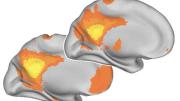Neuroscientists have long used damaged brains as a way to understand normal brain functions. But doing the opposite also works. A group of researchers at Harvard recently looked at the effects of aging on healthy people’s brains and found that as we get older, communication between different brain regions breaks down. This discovery could eventually help scientists better characterize and detect neurodegenerative diseases, including Alzheimer’s, which affects more than 5 million Americans.
Until recently, most scientists looking at the aging brain focused on individual regions, especially those in the frontal lobe, which may shrink or lose activity even in the absence of disease, says Jessica Andrews-Hanna, a doctoral student in psychology at Harvard’s Center for Brain Science and the lead author on the group’s paper (published last December in the journal Neuron). Though other investigators had hypothesized that disconnections might occur in the ebb and flow of signals between regions, it wasn’t easy to measure this until the introduction in the early 1990s of functional magnetic resonance imaging (fMRI), a scanning technique that measures blood flow.
Andrews-Hanna and her colleagues looked at data collected by researchers at Washington University in St. Louis who studied 93 healthy adults between the ages of 18 and 93. (All were prescreened for Alzheimer’s and other neurological diseases.) While lying in an fMRI scanner, the subjects classified single words on a screen as referring either to living or non-living objects. Andrews-Hanna then looked at neural activity during the task in two large-scale networks that span the brain: the default network, used when we’re worrying, thinking of the past and future, or imagining people in our lives; and the attention network, used when we’re focusing on a specific task, such as word processing or math problems.
The scientists found that among young people (in this case, those under 35), the brain regions that make up each distinct network were largely in sync with one another—when one region was activated by the task, the other was, too. But among adults over 60, the brain scans revealed a lot of variation. Some participants’ scans showed almost the same level of synchrony as those of their younger counterparts, but others’ had dropped to zero. When the researchers then used a more direct test to measure communication between regions, they found that those older adults whose brain networks were out of sync also showed a degradation in their white matter, the nerve tissue insulating the brain circuits that support communication. In particular, they noticed, communication lines between the front and back of the brain within the default network (which we also use to daydream) degrade more in older adults than those in the attention network.
“What was really surprising to us was the degree of the effect,” says Andrews-Hanna. “We thought there would be a difference in correlation between young and old adults, but we had absolutely no idea that it would diminish to zero.” She says the implications of the finding aren’t clear. In the study, several of the older adults also took tests measuring their memory, abstract reasoning powers, and processing speed and, not surprisingly, those who performed best were also those whose brain regions were most in sync. Andrews-Hanna is interested in further exploring the default network, whose functions she says are still largely unknown. She’s also hoping to do follow-up studies to look at whether daydreaming declines with age.
The correlation approach that Andrews-Hanna used for the study could also be used to explore how Alzheimer’s affects different brain regions, she says. Scientists have typically focused on one region, the hippocampus, but as technology improves, they’re discovering that the disease affects many parts of the brain—and perhaps the relationships among them. Certainly, having a clear picture of the normal aging brain could prove useful for its own sake. Andrews-Hanna suggests a rehabilitation approach: perhaps, she says, we could someday disrupt the effects of natural aging by playing mental games that encourage communication between brain regions.








